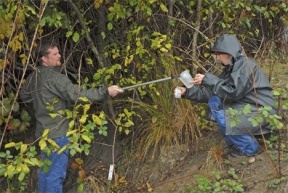FREELAND — The Holmes Harbor Shellfish Protection District has a thirst that hopefully can be quenched in the coming rainy season.
As Freeland sees more rain during the fall and winter months, members of Island County’s Resource Enhancement Program have already begun taking water quality samples from streams and watersheds that drain into Holmes Harbor.
In March, Island County’s Board of Commissioners approved the formation of the Holmes Harbor Shellfish Protection District after shellfish harvesting was banned within the southern portion of the harbor.
The county formed the district after the Washington State Department of Health discovered elevated levels of fecal coliform bacteria in four of six drains that feed freshwater to the harbor.
Dry weather during the months following the creation of the district hindered county workers from collecting water quality samples, and that’s essentially stopped any progress in reopening the area to shellfish harvesting.
The sampling locations in basins and smaller watersheds provided little data and no place to start, said Chris Wilson, resource enhancement manager for Island County.
“We ran out of time to do any monitoring. By the time we found out how water moves around the whole area, and got prepared to deploy into those areas, the water was gone,” Wilson said.
With the rain returning, county collection crews have fanned out to collect water samples. The county is attempting to follow the path of fecal coliform upstream to its sources.
And, Wilson said, they are getting closer every time they go out and collect samples.
“From a progression point of view, we are in a position where we will begin to see some activity in the watersheds. Readers will probably see sample crews out and about doing water quality sampling.”
“This winter, we’re going to be in a better position than we were last spring to start source identification site work in the basins,” he said. “In two of the six basins, we have enough data collected to begin making decisions.”
Though the ban against collecting shellfish remains in effect, there has been no evidence indicating shellfish contamination, Wilson said. The effort is based now on risk management.
“It is only based upon risk. There is an elevated risk because of the potential for pollution,” he said. “People aren’t supposed to be shellfish harvesting now, and they run an increased risk if they do until we resolve the impairment issues.”
“When we close an area, it doesn’t mean that an area is grossly contaminated,” Bob Woolrich, manager of the Growing Area Section of the state Office of Shellfish and Water Protection. “It just doesn’t meet the standard.”
“It is a very high standard to meet,” he added. “Clams and oysters can filter a huge quantity of water. Shellfish have to be grown in extraordinarily clean water because they have the capacity to concentrate contaminates, particularly bacteria and viruses.”
Because of the current lack of quantifiable data, Wilson believes it is premature to predict the source of the contamination.
“It is jumping the gun to give a guess as to where the fecal coliform is coming from,” he said.
“It could be wildlife. You could have a bird migration that happens in the headlands of the watershed that may be causing the impairment.”
Wilson did offer some potential causes however.
“I think you might have a myriad of things; septic systems in a highly developed area or some contributions from some agricultural uses,” he said.
Homes and business in the area also have on-site septic systems, he said. “All those things combined could potentially be leading to impairment of the fresh water.”
Woolrich agreed there may be multiple sources of pollution.
“Could it be birds or wildlife? That is a possibility. I think there is more to it than that,” Woolrich said. “It is often a mix. Wildlife is oftentimes a contributor, as well as humans and other animals; dogs, birds, seals, whatever.”
While the county is collecting samples and following bacterial trails, Wilson said it will take an extensive effort to fix the pollution problem and eventually dissolve the district.
“People need to realize that we can’t do it alone. The county can’t solve the problems alone,” Wilson said. “The whole community needs to get engaged in this.”
Without the community’s assistance, Wilson said it might take longer to achieve dissolution of the district.
“Every little drop of water or potential fecal coliform that lands on the ground will end up in the watershed,” he said. “Until we can prove that all the water that drains into the bay is clean, we’re not going to be able to dissolve the district and restore the uses of Southern Holmes Harbor. It behooves everyone to cooperate.”
Spencer Webster can be reached at 221-5300 or swebster@southwhidbeyrecord.com.



